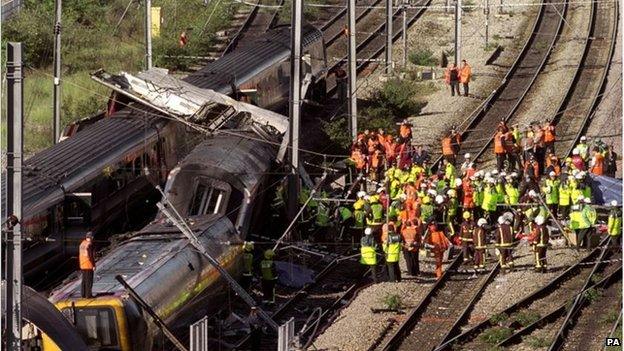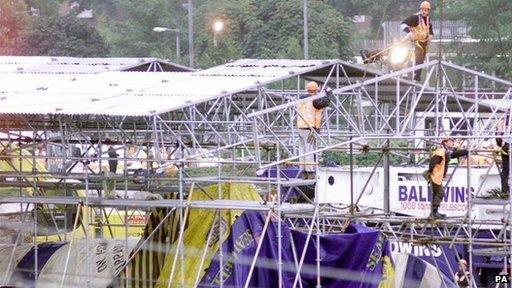Paddington rail disaster remembered 15 years on
- Published

In total, 31 lives were lost when two trains collided on 5 October 1999
Those bereaved by the Paddington train crash have marked the 15th anniversary of the disaster with a ceremony.
They have placed flowers at a memorial site high above the railway line at Ladbroke Grove in west London.
Just before 08:10 BST on 5 October 1999, 31 people died when two trains collided almost head-on.
The subsequent inquiry found the Thames Trains service travelling from Paddington to Bedwyn in Wiltshire had gone through a red signal.
It then crashed into the London-bound high-speed First Great Western train which had left Cheltenham Spa in Gloucestershire at 06:03.
The Thames driver, Michael Hodder, 31, and the other train driver, Brian Cooper, 52, were among those killed as the collision led to a fireball in which coach H was burnt out.
As well as the fatalities, more than 220 people were injured.
'Lives changed'
Paddington Survivors group chairman Jonathan Duckworth, 56, from Stroud in Gloucestershire, was on the First Great Western train.
Father-of-two Mr Duckworth said: "Luckily, I was only in hospital for around 24 hours but then I suffered from post-traumatic stress disorder.

Thirty one people died and more than 220 people were injured in the crash
"I had to have about 18 months of treatment and was only able after that to take on small, part-time jobs.
"It was six or seven years before I was able to work full-time again."
The Paddington disaster was followed by fatal rail crashes at Hatfield in Hertfordshire in 2000, at Selby in North Yorkshire in 2001 and at Potters Bar in Hertfordshire in 2002.
Michael Roberts, director-general of the Rail Delivery Group, which speaks on behalf of Network Rail and the train operators, said: "We remember those who lost their lives and all those whose lives were changed as a result of the Paddington crash.
"After serious accidents in the early 2000s, changes such as an overhaul of employee training for those doing safety-critical jobs and a better approach to staff working hours have helped improve safety on Britain's railway."